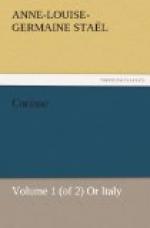Oswald and Corinne passed on to the hall where are collected together the sculptured images of animals and reptiles; and the statue of Tiberius is found, by chance, in the midst of this court. This assemblage is without design. Those statues appear to have ranged themselves of their own accord about their master. Another hall enclosed the dull and rigid monuments of the Egyptians; of that people whose statues resembled mummies more than men, and who by their silent, stiff, and servile institutions, seem to have assimilated as much as possible, life to death. The Egyptians excelled much more in the art of imitating animals than in representing men: the dominion of the soul seems to have been inaccessible to them.
After these come the porticos of the museum, where at each step is seen a new masterpiece. Vases, altars, ornaments of every kind, encircle the Apollo, the Laocoon, and the Muses. It is there that we learn to feel Homer and Sophocles: it is there that a knowledge of antiquity is awakened in the soul, which cannot be acquired elsewhere. It is in vain that we trust to the reading of history to comprehend the spirit of nations; what we see inspires us with more ideas than what we read, and external objects cause in us a strong emotion, which gives that living interest to the study of the past which we find in the observation of contemporary facts and events.
In the midst of these magnificent porticos, which afford an asylum to so many wonders of art, there are fountains, which, flowing incessantly, seem to tell us how sweetly the hours glided away two thousand years ago, when the artists who executed these masterpieces were yet alive. But the most melancholy impression which we experience at the Vatican, is in contemplating the remains of statues which are collected there: the torso of Hercules, heads separated from the trunks, and a foot of Jupiter, which indicates a greater and more perfect statue than any that we know. We fancy a field of battle before us, where time has fought with genius; and these mutilated limbs attest its victory, and our losses.
After leaving the Vatican, Corinne conducted him to the Colossi of Mount Cavallo; these two statues represent, as it is said, Castor and Pollux. Each of the two heroes is taming with one hand a fiery steed. These colossal figures, this struggle between man and the animal creation, gives, like all the works of the ancients, an admirable idea of the physical power of human nature. But this power has something noble in it, which is no longer found in modern society, where all bodily exercises are for the most part left to the common people. It is not merely the animal force of human nature, if I may use the expression, which is observable in these masterpieces. There seems to have been a more intimate union between the physical and moral qualities among the ancients, who lived incessantly in the midst of war, and a war almost of man to man. Strength of body and generosity




